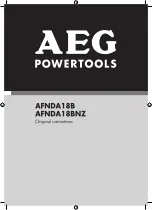
Do not exceed maximum recommended air pressure
marked on the tool.
Verify prior to using the tool that the air
source has been adjusted within the rated air-pressure
rang. Be sure the air pressure gauge is operating properly
and check it at least twice a day. Tools operated in excess
of their maximum pressure rating may operate abnormally
or burst resulting in personal injury.
To connect the tool to the compressor only use pneumatic
air hoses that meet the following criteria:
FIG. 4
Minimum hose pressure rating, 200PSI.
Minimum hose inner diameter, 1/4 in.
Maximum hose length, 100 ft.
Connect the air supply:
Snap the air hose onto the quick connector.
Check for air leakage. If leakage is noted, stop using the
tool immediately and performed by qualified repair
personnel.
Be sure the air pressure gauge is operating properly and
check it at least twice a day.
TOOL TESTING
OPERATORS AND OTHERS IN WORK AREA MUST WEAR
SAFETY GLASSES WITH SIDE SHIELDS WHICH CONFORMS
TO ANSI Z87.1 SPECIFICATIONS.
NEVER USE TOOL UNLESS SAFETY IS OPERATING
PROPERLY.
Before actually beginning the nailing work, test the tool by
using the check list below. Conduct the test in the following
order.
If abnormal operation occurs, stop using the tool and
performed by qualified repair personnel immediately.
against the wood.
Separate the safety from the wood. Next, point the tool
downward, pull the trigger and then wait in that position
for 5 seconds or longer.
1). Without touching the trigger, depress the safety
against the workpiece. Pull the trigger.
2). Hold the trigger back while separating the safety
from the wood.
The tool will remain in operated status(the driver blade
will remain at the bottom).
3). Remove the finger from the trigger.
Tool operation will end (the driver blade will return to the
top).
If no abnormal operation is observed, you may load
nails in the tool. Drive nails into the workpiece that is the
same type to be used in the actual application.
THE TOOL MUST NOT OPERATE.
THE TOOL MUST NOT OPERATE.
THE TOOL MUST OPERATE
THE TOOL MUST OPERATE PROPERLY.
4.
5.
6.
5
1.
2.
3.
WARNING
WARNING
DANGER
Disconnect air hose from tool. Remove all nails from
tool.
If any screws are
loose, tighten them.
Adjust the air pressure to 70PSI, connect the air hose.
Do not load any nails in the tool.
Remove the finger from the trigger and press the safety
ALL SCREWS MUST BE TIGHTENED.
THE SAFETY AND TRIGGER MUST MOVE SMOOTHLY.
THE TOOL MUST NOT LEAK AIR.
1.
2.
3.
NAIL LOADING
When loading the tool s magazine, check that the nail tips
contact the wear rail and slide smoothly against the surface
of the magazine.
If the nails are not loaded properly, the
tool will misfire and nails can be deflected, causing the tool
to react in an unexpected manner, and damage the tool.
Connect air supply.
Press magazine latch and pull magazine to open
position (FIG 5).
See tool specification to determine appropriate nail
sizes. Insert appropriate nail strips, with the nail tips
contacting the wear rail (FIG 6).
Push the nail strip against the nose.
Push magazine fully closed. Magazine latch will maintain
fully closed position.
1.
2.
3.
4.
5.
PRESS
PULL OPEN
FIG. 5
WARNING
FIG. 6
"F" Nail
18Ga.
Nail tips contact
wear rail
Push
Against
nose





























